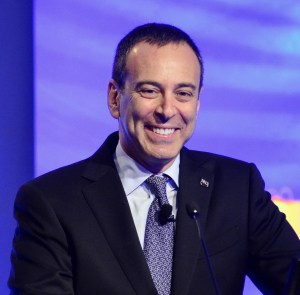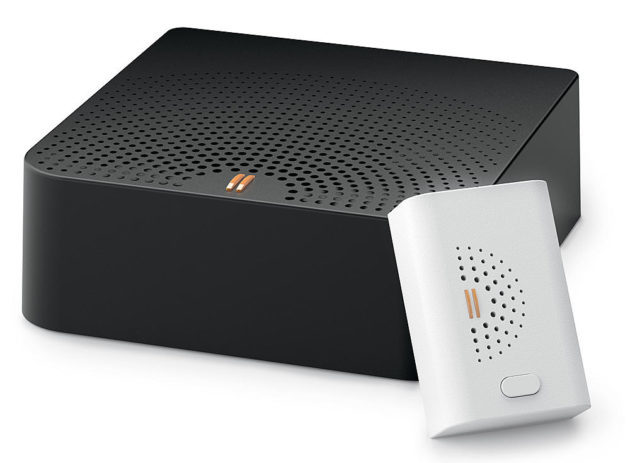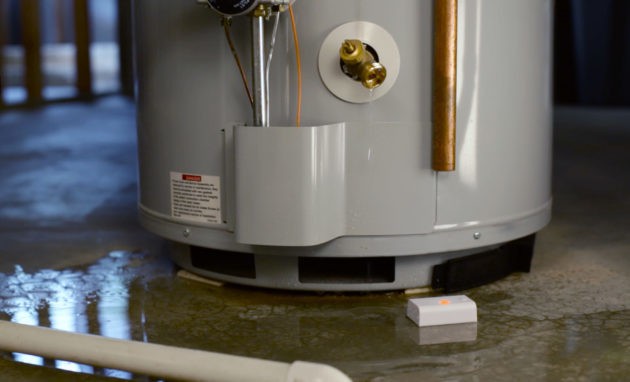Parag Garg, Wally Labs chief technology officer and chief product officer, and vice president of Sears Holdings; and Ryan Ciovacco, Sears president of Connected Living and WallyHome, with the new WallyHome Starter Kit in the company’s engineering office in Seattle’s University District. (GeekWire Photo / Todd Bishop)
One of the people who sometimes jumps into the Slack channel for the Seattle-based WallyHome sensor company is a colleague named Eddie — offering support and guidance from his office in the Miami area. That would be Edward S. Lampert, CEO of Sears Holdings Corp., which acquired WallyHome a year ago.
 Sears Holdings Corp. CEO Edward Lampert
Sears Holdings Corp. CEO Edward Lampert
Lampert sees WallyHome and the Internet of Things “as a big opportunity,” said Ryan Ciovacco, Sears president of Connected Living and WallyHome, in an interview this week. “He’s given us a lot of autonomy to do what we need to do. Obviously he gives guidance, but he has allowed us to do a lot, and the rest of the company has followed suit in supporting us.”
With that support from the top, WallyHome has grown rapidly — now employing about 60 people, up from six when the retail giant acquired the WallyHome sensor technology from Seattle startup SNUPI Technologies, a University of Washington spinoff company, in October 2015.
The big bet by Sears on WallyHome is especially notable and potentially significant given the current struggles of some of the company’s traditional retail brands.
The existing WallyHome technology detects water leaks and alerts homeowners and building managers to problems caused by changes in moisture, temperature and humidity. But the company is working to expand the capabilities of the WallyHome system well beyond water and moisture. In the future, executives say, the base station will work with a variety of connected devices and sensors, from WallyHome and other companies.
As an initial step, WallyHome just released its first new product since the Sears acquisition: a WallyHome Starter Kit with a redesigned base station and sensor for $100. Individual sensors cost $35. That’s a major departure from the pricing strategy for WallyHome under SNUPI, which sold a base station and six sensors for about $300.
 The revamped WallyHome base station and sensor. (Image via Sears)
The revamped WallyHome base station and sensor. (Image via Sears)
New features of the system include the ability to detect open doors and windows.
Other new features include a digital speaker in the base station for leak notifications, and a battery backup in the WallyHome hub in case the power goes out. The sensors also include a local alarm, supplementing the text messages, mobile notifications from the WallyHome app, and automated phone calls that users can receive when the system detects something wrong.
The new base station uses industry standard connected-home radios, and “over time, it will become compatible with more and more connected home products,” said Parag Garg, Wally Labs chief technology officer and chief product officer, and vice president of Sears Holdings.
“This is the shot across the bow,” Garg said. “This is our start. But there’s definitely a lot more that we’re doing. We’re being thoughtful about how we’re doing it. It’s not, for us, about demonstrating 50 compatibilities that customers may not find interesting right away. It’s about making sure that we’re solving for specific pain points and thinking those through.”
In addition, the company is testing a possible paid service that would offer WallyHome users live assistance via phone, allowing a customer service agent to guide a user through the process of shutting off the water or otherwise mitigating a leak or other problem in the home. The agent could also dispatch a technician or contractor via Sears Home Services to fix the problem.
 A WallyHome sensor detects a leak next to a water heater. (Image via Sears)
A WallyHome sensor detects a leak next to a water heater. (Image via Sears)
WallyHome is also working on integrations with some Sears home appliances, leveraging another of the company’s traditional product lines.
“We want to own the health of the home,” Ciovacco said. “The overall vision is really a full solution.”
In pursuing its connected-home services strategy, Sears is competing against a wide variety of existing players, ranging from tech giants such as Amazon to startups and device manufacturers. Ciovacco and Garg both worked previously at Amazon, among other companies. Sears Home Services also established an engineering center in downtown Seattle last year.
WallyHome traces its roots to technology developed inside the University of Washington by professor Shwetak Patel. It spun out of the UW under the corporate umbrella of SNUPI Technologies, led by veteran entrepreneur Jeremy Jaech. Prior to the Sears acquisition of WallyHome, SNUPI laid off a significant portion of its staff and shelved the Wally sensors after it was unable to raise additional venture funding.
Under Sears, the company has been able to rehire some of those former SNUPI employees in its Seattle office, next to the University of Washington campus, where the bulk of the WallyHome team now works. WallyHome also has employees at Sears headquarters in Hoffman Estates, Ill., in downtown Chicago, and in India and Asia. The company also maintains ties to the UW through internships and other initiatives.







